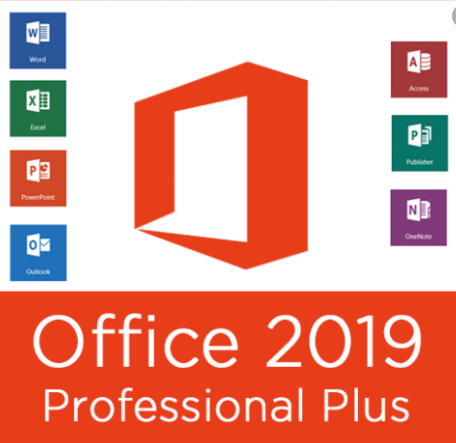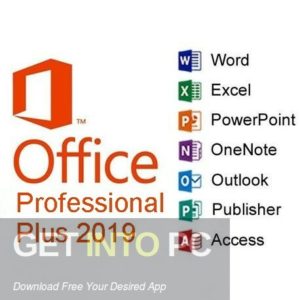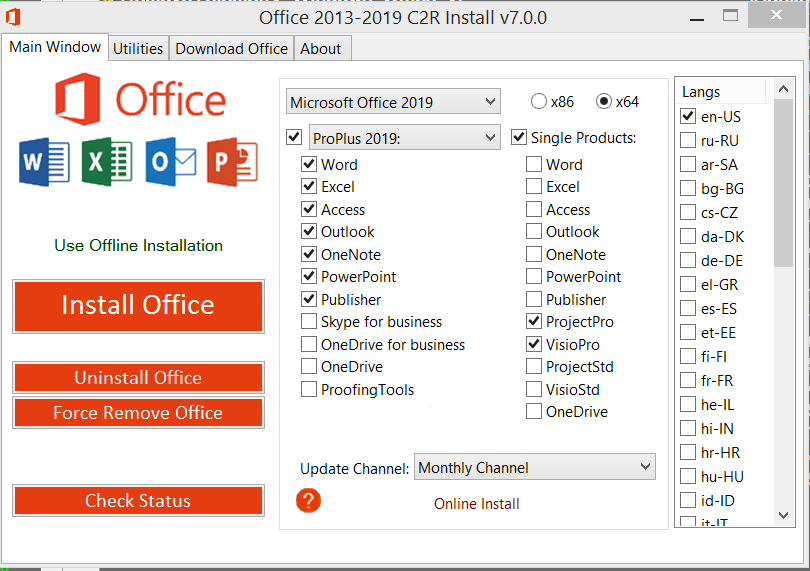We have 3 versions that can be considered currently 1. Office 2013 Professional 2. Office 2016 Professional 3. Office 365 Ill list all the features so that you can decide Office 2013. One time purchase. 3 years old. No future upgrades. Securit. Microsoft Office 2019 for Windows provides 5 years of mainstream support plus two 2 years of extended support as an exception to the 10-year Fixed Lifecycle Policy term. This seven-year term aligns with the support period for Office 2016. Office 2019 is supported on the following. If you want Microsoft Office 2019, you're going to need Windows 10. The upcoming productivity app update drops Window 7 and Windows 8.1 support.
-->Important
- Support for Windows 7 ended on January 14, 2020. Learn more
- Microsoft 365 Apps is no longer supported on Windows 7.
- If you're a home user running Office on Windows 7, see Windows 7 end of support and Office instead of reading this article.
Office 365 and Microsoft 365 are governed by the Modern Lifecycle Policy, which requires customers to stay current as per the servicing and system requirements for the product or service. This includes using Microsoft 365 Apps on a Windows operating system that is currently in support.

Using Microsoft 365 Apps on older, unsupported operating systems may cause performance and reliability issues over time. Therefore, if your organization is using Microsoft 365 Apps on devices running Windows 7, we strongly recommend your organization moves those devices to Windows 10.
Security updates will continue for Microsoft 365 Apps on Windows 7
Even though Windows 7 is no longer supported, we've decided to continue to provide you with security updates for Microsoft 365 Apps for the next 3 years, until January 2023. Itunes os x 10.11 4. We're doing this to give you additional time to make the transition from using Microsoft 365 Apps on devices running Windows 7 to devices running a supported operating system, such as Windows 10. But, during that time, as long as the device is still running Windows 7, your installation of Microsoft 365 Apps won't receive any new features updates.
Important

- Even with these security updates, Microsoft 365 Apps is no longer supported on Windows 7.
- This information applies even if you have purchased Extended Security Updates (ESU) for Windows 7. After January 2020, security updates for Windows 7 are only available with ESU. For more information, see FAQ about Extended Security Updates for Windows 7.
How to manage Microsoft 365 Apps on Windows 7 after January 2020
Version 2002 is the last version of Microsoft 365 Apps that you can install on devices running Windows 7. Version 2002 is available in Current Channel, Semi-Annual Enterprise Channel (Preview), and Semi-Annual Enterprise Channel.
This means that if you want to continue to deploy and update Microsoft 365 Apps on devices that are running Windows 7, you need to use Version 2002. If you try to install a newer version of Microsoft 365 Apps, such as Version 2005, on a device running Windows 7, you'll receive an error message.
Note
You can continue to use a version of Microsoft 365 Apps earlier than Version 2002 on devices running Windows 7 if that version is still available. For example, you can continue to use Version 1908 of Semi-Annual Enterprise Channel until March 2021. To see the version available in each update channel of Microsoft 365 Apps, refer to the table in Update history for Microsoft 365 Apps.
To deploy or update Version 2002 on devices running Windows 7, you can keep using the same management tools that you're currently using, such as the Office Deployment Tool or Microsoft Endpoint Configuration Manager. Also, Microsoft 365 Apps can remain on the same update channel as before.
If Microsoft 365 Apps is configured to get updates directly from the Office Content Delivery Network (CDN) on the internet, Microsoft 365 Apps on devices running Windows 7 will be updated automatically to the most current release of Version 2002 for that update channel.
Guidance when using Configuration Manager for updates
If you use Configuration Manager and the Software Update management workflow to update installations of Microsoft 365 Apps, we recommend that you create a separate collection for your Windows 7 devices. Then, use a query rule to add members to the collection.
On the 2nd Tuesday of each month, a new update package for Version 2002 that is only for devices running Windows 7 will be made available in the Microsoft Update Catalog. There will be an update package for each architecture (x86 or x64). That update package can be used with whichever update channel of Microsoft 365 Apps you have deployed. There won't be separate update packages of Version 2002 for each update channel. For example, the same update package can be used to update a Current Channel or a Semi-Annual Enterprise Channel installation of Microsoft 365 Apps on devices running Windows 7.
In the Office 365 Updates node, you'll see entries like the following, where ##### will be replaced by the most current build number:
- Microsoft 365 Apps Update for Windows 7 – Version 2002 for x64 based Edition (Build 12527.#####)
- Microsoft 365 Apps Update for Windows 7 – Version 2002 for x86 based Edition (Build 12527.#####)
These update packages are configured to apply only to devices running Windows 7. These update packages can't be used to update Microsoft 365 Apps on devices running other supported operating systems, such as Windows 10.

If you use an automatic deployment rule (ADR), you should create a new rule for these update packages. Then, use the new rule for your collection that contains your Windows 7 devices. We recommend using the 'Title' property and searching for 'Microsoft 365 Apps Update for Windows 7' as well as the architecture you support. If you support both x86 and x64, you can include both updates in one Software Update Package as clients will apply the appropriate update. You should also check other existing ADRs to make sure they don't incorrectly try to apply these update packages, which are only for devices running Windows 7, to devices running other operating systems.
Extended availability of Version 2002
/cdn.vox-cdn.com/assets/2087101/microsoftofficestock.jpg)
Version 2002 will be available until January 2023 and will receive security updates, as needed, during that time. For a list of security updates included in releases of Version 2002, see Release notes for Microsoft 365 Apps Security Updates.
Versions of Semi-Annual Enterprise Channel are available usually for only 14 months, but we're making an exception for Version 2002 in order to align with the availability dates of Windows 7 ESU. This extended availability for Version 2002 also applies to other update channels, such as Current Channel and Semi-Annual Enterprise Channel (Preview).
The extended availability of Version 2002 until January 2023 applies only to devices running Windows 7.
After moving Microsoft 365 Apps to a supported Windows operating system
After you move Microsoft 365 Apps to a supported Windows operating system, you can configure Microsoft 365 Apps to begin receiving newer versions and feature updates again. Since updates for Microsoft 365 Apps are cumulative, you'll receive all the feature updates that you missed while your device was running Windows 7.
If you're getting updates directly from the Office CDN on the internet, after the device is moved to a supported operating system, Microsoft 365 Apps will be updated automatically to the most current version available for that update channel and will start receiving new features again.

What about other versions of Office on Windows 7?
Non-subscription versions of Office used by organizations, such as Office Professional Plus 2016 or Office Standard 2013, will continue to be supported based on the Fixed Lifecycle Policy. To see specific end of support dates for non-subscription versions of Office, go to Search Product and Services Lifecycle Information.
Even if your version of Office is still supported, Windows 7 will no longer receive security updates after January 2020, leaving it vulnerable to security threats, unless you have ESU. We recommend that you move to a supported operating system, such as Windows 10.
Additional information
- This information also applies to the following products:
- The subscription versions of the Project and Visio desktop apps. For example, if you have Project Plan 5 or Visio Plan 2.
- Microsoft 365 Apps for business (previously named Office 365 Business), which is the version of Office that comes with some Microsoft 365 business plans, such as Microsoft 365 Business Premium.
- For information about Windows Server 2008 R2, see Windows Server end of support and Microsoft 365 Apps.
- For end of support dates for different versions of Office on various versions of Windows, see the Office configuration support matrix.
- Other Microsoft resources are available to help you make the transition to using Microsoft 365 Apps on devices running Windows 10, including FastTrack and App Assure.
- To discuss or learn more about end of support for Office versions, visit Microsoft Office End of Support on the Microsoft Tech Community.
- If you're using Microsoft 365 Apps for enterprise on a device running Windows 7 or Windows Server 2008 R2, you'll continue to see Office 365 ProPlus under the Product Information section when you go to File > Account in an Office app, such as Word. If you're using Version 2002 of Microsoft 365 Apps for business, you'll see Microsoft 365 for business under the Product Information section.
Microsoft Office 2013 turns your computer into one of the most effective tools in your home and allows you to create and edit documents.
The days of purchasing a computer and finding that it came loaded with all the apps and programs you need are a thing of the past. Even if you spend thousands on a computer from a top manufacturer, you'll likely find that it lacks simple software like Microsoft Office. This free trial of Microsoft Office 2013 lets you explore all the features of this software for up to 30 days without paying a dime.
One of the biggest features of this download is the access you get to Word 2013. Word is one of the most popular word processing programs in the world today. You can create, edit and save documents, and when you save your work, you can even save those documents for use with older versions of Word. Word also lets you insert charts and photographs into your documents, which comes in handy when doing projects for work.
In addition to Word 2013, you also get access to Excel 2013. Excel helps you create spreadsheets in a fraction of the time that you can share with others. You'll also receive Outlook 2013, which you can use to check your email. Other programs that come with the download include the 2013 versions of PowerPoint, Publisher and Access. Use the included Lync as a new instant messenger to stay connected with friends, family and even coworkers.
Office 2019 Requirements Windows
Even if you used Microsoft Office in the past, you'll find some new features on the 2013 version. Word now works on touchscreens to help you scan and scroll quicker without reaching for your mouse, and you can now view PDF files in seconds. Instead of opening another program, searching for the right file on your computer and then opening that file, Microsoft Office now lets you instantly open those PDF files and even edit those documents.
You'll also love the new presenter mode that comes with PowerPoint. This splits the screen into two different components. One appears on your larger screen and lets those watching follow along, but the second creates a version of the presentation that you can read on your own computer screen. The 2013 Microsoft Office free download lets you try out all the new features of the software suite before investing any money.
Microsoft Office 2019 For Windows 7 Free
Pros:
- Designed to work effectively on traditional computer screens and touchscreens
- Comes loaded with software like Word, Excel, PowerPoint and Access
- Features helpful tips on using each piece of software and making changes
- Allows users to embed videos and images with HTML coding
- Includes a free trial of Lync and Outlook to help users stay connected
Cons:
- Lack of storage space requires that users opt for cloud storage
- Limits the work users can do on touchscreens and tablets
- Frequently pops up warnings near the end of its trial